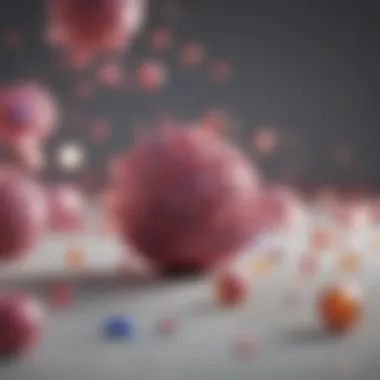Immunotherapy for Estrogen Positive Breast Cancer


Research Overview
The evolving landscape of immunotherapy for estrogen receptor-positive breast cancer has opened new possibilities for patient care. This exploration sheds light on the interplay between the immune system and cancer treatment, particularly focusing on estrogen receptor-positive cases. With traditional hormonal therapies like tamoxifen and aromatase inhibitors long serving as the standard, recent innovations in immunotherapy present a compelling shift in therapeutic strategies.
Research has shown that while hormonal therapies are effective for many patients, a substantial number experience recurrence or treatment resistance. This highlights the need for alternative or adjunctive approaches, leading to the rise of immunotherapy. By harnessing the body’s immune response, these methods aim to enhance treatment efficacy and provide a tailored approach to each patient’s unique tumor biology.
Summary of Key Findings
Recent studies have unveiled several key findings regarding the effectiveness of immunotherapy in treating estrogen receptor-positive breast cancer. A few important points include:
- Increased Efficacy: Immunotherapies have shown promise in improving patient outcomes, especially for those with advanced stages of the disease.
- Combination Approaches: Combining immunotherapy with traditional hormonal treatments can lead to enhanced responses in resistant cases.
- Biomarkers: Identifying specific biomarkers can help predict which patients are likely to benefit from immunotherapy.
Background and Context
The background of estrogen receptor-positive breast cancer is critical to understanding the rationale behind immunotherapy approaches. Approximately 70% of breast cancers are classified as estrogen receptor-positive. This subtype responds to estrogen, which fuels the cancer's growth. Traditional treatments have centered on blocking or lowering estrogen levels. However, research suggests that simply targeting hormone pathways might not be sufficient for all patients.
Immunotherapy, which has shown effectiveness in cancers like melanoma and lung cancer, represents a promising new avenue. Recent FDA approvals for checkpoint inhibitors and CAR T-cell therapies in various cancers underscore the urgency of exploring similar treatments for breast cancer.
As the body of research expands, it becomes imperative to evaluate not just the mechanisms of these therapies but also their clinical applications. This transition from traditional to immune-based strategies holds significant implications for changing treatment paradigms.
Methodology
Utilizing a well-structured approach, contemporary research focuses on both experimental design and data collection techniques to evaluate the effectiveness of immunotherapy.
Experimental Design
Studies often employ clinical trials that compare standard treatments with new immunotherapeutic agents. These trials follow strict protocols to ensure reliability and accuracy. Aspects such as patient demographics, cancer staging, and previous treatments are meticulously documented.
Data Collection Techniques
Data is collected using various techniques:
- Patient Surveys: Feedback about treatment responses.
- Biopsies: To determine immune cell presence and activity.
- Blood Tests: Evaluating biomarkers related to immune response.
This data plays a crucial role in understanding how immunotherapies interact with hormonal treatments, offering insights into patient-specific responses. Analyzing these correlations allows for a deeper understanding of potential therapeutic pathways.
The ongoing study in this field highlights the significance of innovation and personalized medicine. As the research evolves, it lays a foundation for improved treatment outcomes in estrogen receptor-positive breast cancer patients.
Prelims to Estrogen Positive Breast Cancer
Estrogen positive breast cancer, or estrogen receptor-positive breast cancer, represents a major segment of breast cancer cases. It is paramount to discuss this type of breast cancer as it significantly influences diagnosis, treatment plans, and patient outcomes. Understanding its nuances sets the foundation for comprehending how immunotherapy can be integrated into existing treatment protocols.
Defining Estrogen Positive Breast Cancer
Estrogen positive breast cancer is characterized by the presence of estrogen receptors on the surface of cancer cells. These receptors enable cancer cells to respond to estrogen, which can promote their growth. This type of cancer typically comprises a substantial portion, about 70% of all breast cancer diagnoses. The presence of estrogen receptors is pivotal in determining treatment pathways. It enables the use of hormonal therapies like tamoxifen or aromatase inhibitors that signal the cancer cells to stop growing by blocking the effects of estrogen.
Epidemiology and Risk Factors
Estrogen positive breast cancer occurs more frequently in women than in men, with varying risk factors contributing to its prevalence. Age is a significant risk factor; women over 50 are at a higher risk, particularly during and after menopause when estrogen levels fluctuate. Genetic factors also play a role, with mutations in genes such as BRCA1 and BRCA2 increasing one's susceptibility. Other factors include family history, body mass index, and lifestyle choices. Recent studies indicate that women with a higher body mass index after menopause face an elevated risk of developing estrogen receptor-positive breast cancer. Adopting healthy lifestyle choices may mitigate some of these risks, but genetics often remain a decisive factor. Understanding these elements helps shape preventive strategies, interventions, and refined screening processes.
Understanding Immunotherapy
Immunotherapy represents a transformative shift in cancer treatment, particularly for estrogen-positive breast cancers. This section aims to clarify the essence of immunotherapy and why comprehending its mechanisms is vital for both practitioners and patients. As traditional therapies often encounter limitations, immunotherapy provides an innovative approach focusing on harnessing the body's immune system.
Understanding immunotherapy involves grasping how it targets cancer cells while minimizing harm to healthy cells. This approach allows for more precise treatment modalities. By recognizing the mechanisms at play, medical professionals can tailor therapies, enhancing overall patient outcomes.
Given the rising prevalence of estrogen-positive breast cancer, the need for effective treatment alternatives is paramount. Immunotherapy offers several promising benefits, including the potential for personalized treatment plans based on an individual’s unique immune response. This takes us to the basic principles of immunotherapy, which form the foundation of these advancements.


Basic Principles of Immunotherapy
Immunotherapy leverages the immune system's natural capabilities to recognize and destroy cancer cells. Unlike traditional therapies that target the tumor directly, immunotherapy enhances the immune response. This process often involves stimulating immune cells to distinguish between healthy tissue and malignant cells. Understanding this principle is essential for recognizing how it can be applied in estrogen-positive breast cancer.
The primary types of immune responses relevant to immunotherapy include humoral and cellular immunity. Each serves distinct functions in attacking cancer cells. By understanding these responses, it becomes easier to appreciate the range of immunotherapeutic approaches available.
Types of Immunotherapy
The classification of immunotherapy can be broken down into several distinct categories, each presenting unique attributes. The main types discussed in this context include checkpoint inhibitors, monoclonal antibodies, and cell-based therapies. Understanding these types is essential for grasping their roles in treating estrogen-positive breast cancer.
Checkpoint Inhibitors
Checkpoint inhibitors are pivotal in the landscape of immunotherapy, functioning as agents that block specific proteins on immune cells or cancer cells. Their primary contribution is to reinvigorate an exhausted immune response. Key characteristics include their ability to enhance T-cell activity. This is essential since T-cells are integral to effectively combating tumors. Due to their unique mechanism, checkpoint inhibitors have become an important choice in cancer treatment.
One unique feature of checkpoint inhibitors is their potential to achieve durable responses, which can lead to long-term remission in some patients. However, they can also cause unintended immune-related adverse effects, raising considerations for patient selection and management.
Monoclonal Antibodies
Monoclonal antibodies represent another significant aspect of immunotherapy. These are laboratory-engineered molecules designed to target specific antigens on the surface of cancer cells. Their role is not only to directly inhibit tumor growth but also to mark cancer cells for destruction by the immune system.
The key characteristic of monoclonal antibodies is their specificity. They bind to individual targets, allowing for targeted therapy. This makes them a common choice in the treatment of estrogen-positive breast cancer. A unique feature is their versatile application; they can be used alone or in combination with other therapies. Challenges with monoclonal antibodies include the potential for resistance and the high costs associated with their production and administration.
Cell-Based Therapies
Cell-based therapies take a different approach by using the patient's own immune cells to treat cancer. This method often involves enhanced T-cells or natural killer cells that are engineered in the lab to better recognize and attack cancer cells. The benefit of this approach is the potential for tailored treatment based on the individual’s immune profile.
The distinctive feature of cell-based therapies is the customization aspect, enhanced with technologies like CAR-T cell therapy. However, scalability and accessibility remain critical challenges, which can limit widespread application.
In summary, understanding the various types of immunotherapy and their mechanisms is crucial in developing effective treatment options for estrogen-positive breast cancer. The focus on immune responses reshapes the treatment landscape, paving the way for more personalized approaches to therapy.
"This reimagining of cancer treatment emphasizes the need for ongoing research and collaboration within the medical community."
Such insights provide a clear understanding of the emerging role of immunotherapy in breast cancer management, particularly for those who are estrogen receptor-positive. The exploration into this domain continues to reveal promising avenues for subsequent investigation and application.
Mechanisms of Action in Estrogen Positive Breast Cancer
Understanding the mechanisms of action in estrogen-positive breast cancer is crucial for devising effective treatment strategies. This section explores pivotal factors influencing the cancer microenvironment and how therapeutic approaches can exploit these mechanisms to enhance patient outcomes. Insights gained can inform future research and therapeutic developments, presenting a pathway towards improved personalized treatment.
Tumor Microenvironment and Immune Evasion
The tumor microenvironment plays a significant role in the progression of estrogen-positive breast cancer. It is a dynamic and complex milieu formed by tumor cells, immune cells, and various signaling molecules. One key aspect of this environment is its ability to facilitate immune evasion. Tumor cells can create a suppressive microenvironment that impedes the immune system's ability to detect and destroy cancer cells.
Several factors contribute to immune evasion:
- Immunosuppressive Cells: Tumors often recruit regulatory T cells and myeloid-derived suppressor cells that dampen immune responses.
- Cytokine Production: Cancer cells secrete cytokines that promote immunosuppressive conditions, preventing T cell activation.
- Antigen Loss: Tumor cells may lose or downregulate surface antigens that immune cells recognize, allowing them to escape detection.
The challenges posed by immune evasion highlight the need for novel therapeutic strategies. Immunotherapy approaches aim to counteract these evasion mechanisms. For instance, checkpoint inhibitors, which target proteins that downregulate the immune response, have shown promise in reinvigorating T cell activity against tumors.
"Effective immunotherapy requires a comprehensive understanding of the tumor microenvironment."
Role of Estrogen Receptors in Immune Modulation
Estrogen receptors have a significant role in shaping the immune landscape of breast cancer. These receptors are not only involved in tumor growth and proliferation but also in the interaction between cancer cells and the immune system. Estrogen, through its receptors, can influence the behavior of immune cells in the tumor microenvironment.
Some observations include:
- Cytokine Alteration: Estrogen can modify the secretion of various cytokines, which can either promote or inhibit inflammatory responses.
- T Cell Functionality: Evidence suggests that estrogen receptors on immune cells may alter T cell proliferation and activity, which can impact anti-tumor immunity.
- Immune Cell Recruitment: Estrogen may affect the recruitment of immune cells to the tumor site, consequently influencing tumor growth and metastasis.


Understanding how estrogen receptors modulate immune responses opens new avenues for targeted therapies. Combining traditional hormonal therapies with immunotherapeutic agents could enhance efficacy by reprogramming the immune system to respond more favorably against the tumor.
Benefits of Immunotherapy over Traditional Treatments
Immunotherapy represents a frontier in the treatment of estrogen-positive breast cancer, diverging from the established methods that have dominated the landscape for decades. The importance of this topic cannot be overstated, given the rising incidence of this cancer subtype and the complexity of treatment resistance. Immunotherapy offers not merely an alternative but a potentially transformative approach that addresses the limitations inherent in traditional hormonal treatments.
Resistance Mechanisms in Hormonal Therapies
Hormonal therapies, including selective estrogen receptor modulators like Tamoxifen and aromatase inhibitors such as Anastrozole, have been the cornerstone in treating estrogen-positive breast cancer. However, resistance to these therapies is a prevalent issue. Patients often experience primary resistance from the outset or develop secondary resistance after initial success.
Some common resistance mechanisms include:
- Alterations in Hormone Receptors: Changes in estrogen receptor expression can minimize the efficacy of hormonal therapies.
- Intratumoral Estrogen Synthesis: Tumors may produce estrogen internally, undermining the aims of hormonal treatments.
- Cross-talk with Growth Factor Pathways: The interplay between estrogen signaling and growth factor pathways can lead to treatment evasion.
Research indicates that almost 50% of patients develop resistance to hormonal therapies within a decade. This statistic highlights a pressing need for new strategies that can bypass or counteract these mechanisms.
Potential for Personalized Treatment Strategies
One of the most promising aspects of immunotherapy is its adaptability to personalized medicine. Cancer immunotherapy can be tailored to suit the individual patient's tumor characteristics, immune profile, and overall health status. This customization can lead to more effective and targeted treatment outcomes. By identifying specific biomarkers associated with tumor immunogenicity, clinicians can select the most suitable immunotherapeutic agents.
Key advantages of personalized treatment strategies include:
- Targeted Immune Modulation: Immunotherapy can be tailored to activate specific immune responses that directly attack malignant cells.
- Enhanced Efficacy: Customizing treatment based on biomarkers can result in improved outcomes compared to traditional, one-size-fits-all approaches.
- Potential to Overcome Resistance: By leveraging the immune system's adaptive capabilities, personalized immunotherapy may circumvent traditional resistance mechanisms seen in hormonal therapies.
Current Research and Clinical Trials
The landscape of immunotherapy for estrogen-positive breast cancer is rapidly evolving. This ongoing research is crucial for several reasons. First, it offers insights into how these therapies can be optimized to improve patient outcomes. Second, it addresses the limitations of existing treatments, particularly hormonal therapies, which often face issues of resistance and varying efficacy among patients. Understanding these clinical trials is essential for stakeholders, including clinicians, researchers, and patients, as they define the future of treatment paradigms.
Ongoing Clinical Trials of Immunotherapy
Current research includes numerous clinical trials evaluating various immunotherapy approaches. These trials assess the safety and efficacy of immune checkpoint inhibitors, monoclonal antibodies, and personalized strategies targeting specific immune responses. For instance, drugs like pembrolizumab and atezolizumab are being investigated for their potential in conjunction with hormonal treatments.
Clinical trials serve multiple vital functions:
- Assessment of Efficacy: They establish whether a new treatment leads to improved responses compared to current standards.
- Safety Monitoring: They carefully track adverse effects, providing necessary data for future protocols and patient guidelines.
- Biomarker Discovery: Trials frequently focus on identifying biomarkers that may predict who will respond well to immunotherapy, enhancing personalization of treatment.
The involvement of participants is essential in these trials. Their contributions help researchers gather data that could ultimately reshape therapeutic approaches for a significant patient population, thus providing hope where traditional treatments might fall short.
Emerging Biomarkers for Treatment Response
Emerging research is increasingly identifying biomarkers that have the potential to predict treatment responses in patients with estrogen receptor-positive breast cancer. These biomarkers can significantly inform clinical decision-making and therapeutic strategies. Some of the notable markers under investigation include PD-L1 expression, tumor mutational burden, and specific genomic alterations.
- PD-L1 Expression: Studies examine how the level of PD-L1 on tumor cells correlates with responsiveness to certain immunotherapies. High expression often suggests a better likelihood of benefit from checkpoint inhibitors.
- Tumor Mutational Burden: A higher mutational burden may indicate a more robust anti-tumor immune response, suggesting these patients may respond better to immunotherapy.
- Genomic Alterations: Investigating specific gene mutations can provide insight into individual responses to treatments, paving the way for tailored therapeutic approaches.
Understanding these biomarkers not only benefits clinical trial design but also patients directly by guiding personalized treatment options based on their unique tumor characteristics.
These developments illustrate the urgency and significance of current research in optimizing immunotherapy for estrogen-positive breast cancer. By focusing on both clinical trials and biomarkers, the medical community strives to create more effective and individualized treatment modalities.
Challenges in Implementing Immunotherapy
The implementation of immunotherapy in treating estrogen-positive breast cancer presents multifaceted challenges that can significantly influence patient outcomes. While advancements in this field offer hope, there are critical issues that need to be addressed. Understanding these challenges is essential for both the medical community and patients. They encompass varying dimensions, such as the toxicities and side effects associated with treatment and the logistical and economic barriers to accessing these innovative treatments.
Toxicity and Side Effects
Immunotherapy has the potential to revolutionize cancer treatment but comes with a risk of significant toxicity and adverse effects. Unlike traditional chemotherapy, which largely affects rapidly dividing cells, immunotherapy targets the immune system. This can result in unwanted immune responses, leading to autoimmunity and inflammation in healthy tissues.
Some common side effects observed in patients undergoing immunotherapy for breast cancer include:


- Fatigue
- Skin rashes and itching
- Diarrhea
- Endocrine disorders, such as thyroid dysfunction
In severe cases, patients may develop life-threatening conditions like pneumonitis or hepatitis. Managing these side effects requires robust monitoring and supportive care strategies. Moreover, patients must be adequately informed about potential reactions to treatment, enabling them to seek timely medical attention and adjust their treatment plans accordingly. The balance between maximizing therapeutic efficacy and minimizing side effects is a pivotal concern for oncologists.
Logistical and Economic Barriers
Accessibility of immunotherapy remains a pressing issue. Several logistical and economic barriers can restrict patients' abilities to receive necessary treatment. This includes challenges related to health insurance coverage, regional disparities in access to advanced clinical centers, and the overall cost of immunotherapeutic agents.
- Health Insurance Coverage: Some insurance providers may not cover specific immunotherapy treatments, leaving patients in financial distress while seeking alternative funding or assistance. This inconsistency often results in delays in treatment initiation, adversely impacting prognosis.
- Regional Disparities: Patients residing in rural or underserved areas may face significant hurdles in accessing specialized treatment centers. Limited availability of expert medical professionals trained in immunotherapy reduces treatment options for these patients.
- High Costs: The price of immunotherapies is often exorbitant due to the complex manufacturing processes involved. This can put treatments out of reach for many patients, particularly those without sufficient financial resources or lacking comprehensive health plans.
"Addressing the challenges posed by toxicities and access barriers is crucial for the successful implementation of immunotherapy in treating estrogen-positive breast cancer."
The implementation of these strategies requires coordinated efforts from healthcare providers, policymakers, and advocacy groups. Working together, it is possible to create a more favorable environment for patients seeking immunotherapy as a viable treatment option.
Future Directions in Immunotherapy Research
Research in immunotherapy for estrogen-positive breast cancer is rapidly accelerating, opening new avenues for effective treatments. This section examines innovative strategies and highlights important aspects in the future of this field.
Innovative Approaches in Combination Therapy
Combination therapy has emerged as a promising strategy in enhancing the efficacy of immunotherapy for estrogen-positive breast cancer. Researchers are exploring how to synergistically use immunotherapeutic agents alongside traditional hormonal treatments, chemotherapy, or radiation. This approach can potentially improve patient outcomes by targeting multiple pathways essential for tumor growth and immune evasion.
The inclusion of checkpoint inhibitors, for instance, may complement hormonal therapies, counteracting the resistance often seen in patients. Additionally, combining various immune modulators could induce a more robust immune response, increasing tumor clearance. Given that estrogen-positive tumors can modify immune responses, identifying the right combination is crucial.
- Benefits of Combination Therapy:
- Targets multiple mechanisms simultaneously
- Reduces the likelihood of resistance
- Enhances overall survival rates
This strategy holds promise, but research is ongoing. Clinical trials will determine the most effective combinations and dosing regimens to maximize therapeutic benefits.
Potential for Neoantigen Targeting
Neoantigen targeting represents another frontier in immunotherapy that is gaining traction. Neoantigens are unique protein fragments formed due to mutations specific to cancer cells. Because these antigens are not present in normal cells, they are prime candidates for immunotherapeutic intervention without affecting healthy tissue.
The potential of targeting neoantigens in estrogen-positive breast cancer is significant. Personalized vaccines can be designed to provoke a strong immune response against tumor-specific neoantigens.
"Targeting neoantigens could provide a foundation for personalized medicine, adapting treatment to the unique genetic landscape of each patient's tumor."
Furthermore, studies suggest that incorporating neoantigen-targeted therapies may enhance the efficacy of existing treatments. This method might also pave the way for new diagnostic tools to identify which patients will benefit most from such targeted therapies.
- Advantages of Neoantigen Targeting:
- Highly specific toward tumor cells
- Minimizes collateral damage to healthy cells
- Potential to improve immunological memory and fight recurrence
As research evolves, neoantigen targeting could redefine treatment standards for estrogen-positive breast cancer, moving towards more personalized and effective therapeutic strategies.
Culmination
The conclusion of this article emphasizes the evolving landscape of immunotherapy in the treatment of estrogen-positive breast cancer, an area of significant interest in contemporary oncological research. The importance of this topic lies in several key considerations that are crucial for advancing care for patients with this specific type of cancer.
Summary of Key Findings
Throughout the article, we explored multiple dimensions of immunotherapy as it pertains to estrogen-positive breast cancer. It was clear that immunotherapeutic strategies are exploring new avenues and mechanisms that differ greatly from traditional hormonal treatments. Notably:
- Innovations in Immunotherapy: Emerging approaches have shown promise in effectively targeting tumor cells while minimizing damage to healthy tissue.
- Understanding Mechanisms: Insights into how the tumor microenvironment interacts with the immune system are reshaping therapeutic strategies.
- Individualized Treatment: Personalized treatment options based on biomarkers offer a sophisticated approach to enhance clinical outcomes.
These findings reinforce the importance of integrating immunotherapy into treatment protocols for estrogen-positive breast cancer, showcasing the potential benefits that may arise from this strategy.
Implications for Future Treatment Paradigms
The implications of this research extend beyond immediate clinical applications. The integration of immunotherapy signifies a shift in treating estrogen-positive breast cancer, calling for:
- Collaborative Research: Increased collaboration among researchers and healthcare professionals can catalyze innovative solutions in immunotherapy.
- Improved Patient Outcomes: Personalized medicine, understanding tumor behavior, and the immune landscape are critical components that have the potential to improve the quality of life for patients.
- Economic Considerations: Future treatment models must also address cost-effectiveness to make immunotherapy accessible to a broader patient population.







